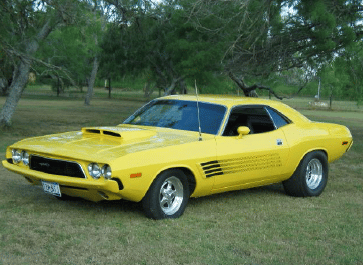It all started back in 1989 when my dad bought a 1973 340 Challenger when I was 11 year old. The car was a numbers matching 340 Rallye car. It was Top Banana Yellow with a black vinyl top and black interior. It had a 340 4 barrel, 727 tranny, and 3.23 posi rear end, overall the car was in pretty good shape. My dad used the car as his daily driver from 1989 through 1995, and then gave the car to me. I drove the car for a few years during and after high school until I got in a wreck.
The car sat for about three years until I finally got the money to start working on it again. My dad, his friend Dewey Perankovich, and I worked on the car almost every evening for about 2 hours for 6 months to complete the car. Dewey took care of the body and paint work which he sprayed a beautiful Viper Bright Yellow with black factory strobe stripes, while my dad and I built the motor. Instead of going back to original on the car I decided to change it a little. We took off the vinyl roof, painted the bumpers body color and put on some 15-inch Weld Pro Star wheels with some bigger rubber. For the engine, we installed a set of Keith Black hypereutectic pistons, ported and polished X-heads, Hughes Engines camshaft with 230 degrees duration and .540-inch lift, and an Edelbrock Performer RPM manifold. On top of that, we installed an Edelbrock 800 CFM carburetor. The transmission was rebuilt by Jeff Carter with a reverse pattern, manual valve body and a 2800 stall torque converter. The car ran pretty well and ran 13.50 ET in Houston. Then after about a year, a wrist pin keeper broke and scarred the cylinder. Now it was time to make a real decision…fix the nice running 340 or was it time to juice it up a bit. I had already scored another complete 340 engine earlier from Joe and Amanda Gonzalez. Well, the decision was relatively simple, though not cheap. I decided to build it right and stroke the 340 to 416 cubes. I ended up using the complete Hughes Engines stroker kit consisting of a Mopar Performance cast 4.00-inch crank, Eagle H-beam connecting rods, Diamond Racing Pistons for a 10.25 compression ratio, a Hughes solid lifter camshaft with 256 degrees duration and .624 inch lift with the 1.6 aluminum roller rockers, a set of ported and polished Edelbrock aluminum heads, and an Edelbrock Victor manifold. After we got the engine back into the car and broken in for 500 miles, we ran it again in Houston and it ran a 12.30 ET. Since then, we have done some tweaking and changed a few things. We replaced the Edelbrock 800 CFM carb with a Mighty Demon 850 that my dad had bought for the 500-cube stroker motor he is building for his ’70 Roadrunner. Next, I replaced the Mopar Performance electronic ignition setup with a hot MSD 6AL control unit with a Blaster 2 coil. With both of these modifications, the car has gone as fast as 11.94 @ 114 mph with a set of 3.91 gears. Remember, this is a 3,650- pound, fully dressed street car. It felt really good to get the car into the 11s, but where does it stop? The more I race the faster I want to go… it’s pretty addictive. I am hoping to get the car to about 11.50 on the motor and still keep it streetable. Until then, I guess I will just keep on trying to get it to go quicker and continue enjoying the car. Remember show and go, so bring those cars out and start running them.
I’d like to thank my dad, Paul Gaspard and Dewey Perankovich for all the help and their time. I would have never been able to do it by myself.

